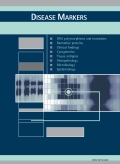Authors: Zintzaras, Elias | Rodopoulou, Paraskevi | Koukoulis, George N.
Article Type:
Research Article
Abstract:
A meta-analysis regarding BsmI, TaqI, ApaI and FokI polymorphisms in the vitamin D receptor (VDR) gene and their associations with osteoporosis in females is reported. The meta-analysis involved 14, seven, seven and three studies for BsmI, TaqI, ApaI and FokI polymorphisms, respectively. The studies were association studies with osteoporotic cases and controls free of osteoporosis that provided the genotype distribution of individual cases and controls. For the BsmI polymorphism, the allele contrast b vs. B showed
…heterogeneity among studies (p< 0.01, I^{2} > 50%) and the random effects (RE) pooled odds ratio (OR) was non-significant: 0.94 [95% confidence interval (CI) 0.63–1.38]. Caucasians, postmenopausal cases and studies with WHO diagnostic criteria showed no association under any genetic contrast. However, in East Asians, the OR for the dominant model [fixed effects OR=0.14 (95% CI 0.04–0.50) and RE OR=0.16 (95% CI 0.03–0.84)] was significant, indicating prevention. Overall, for the TaqI, ApaI and FokI polymorphisms, the allele contrast showed heterogeneity and the pooled RE ORs were non-significant [OR=1.06 (95% CI 0.71–1.60), OR=0.99 (95% CI 0.72–1.37) and OR=1.17 (95% CI 0.76–1.80), respectively]. The allele contrast for Caucasians, East Asians, postmenopausal cases and studies with WHO diagnostic criteria showed no association for TaqI, ApaI, and FokI. The allele contrast of homozygotes, and the recessive and dominant models the results followed the same pattern as the allele contrast. Therefore, the relationship between the VDR polymorphisms and osteoporosis remains an unresolved issue and other probable genetic-environmental risk factors interacting with the above polymorphisms should be investigated.
Show more
Keywords: VDR, osteoporosis, meta-analysis
Citation: Disease Markers,
vol. 22, no. 5-6, pp. 317-326, 2006
Price: EUR 27.50





